“Hedda” Production Designer Cara Brower on Transforming a Stunning Estate for Tessa Thompson’s Rogue Heroine
To re-animate playwright Henrik Ibsen’s famously unhappy heroine Hedda Gabler, writer-director Nia DaCosta cast her longtime muse Tessa Thompson as the star of Hedda (opening Oct. 22). This vivid adaptation, featuring Nina Hoss in the gender-switched role of an ex-lover along with Imogen Poots, Tom Bateman and Nicholas Pinnock, takes place in 1950s England at a raucous party complicated by jealousy, existential angst, feminist fury, a precious manuscript and one handgun.
The movie marks production designer Cara Brower‘s third collaboration with DaCosta, following 2021’s Candyman and The Marvels in 2023. Brower, who previously art-directed Twin Peaks: The Return, Hail Caesar and Us, says “When I first read Nia’s Hedda script, I thought, ‘Wow this is a really terrible person.’ But then, when I saw Tessa as Hedda, she brought something very mischievous to the table. She’s the life of the party and so magnetic you can’t take your eyes off her.”
Speaking from her home in Pasadena, Brower talks about how she transformed a 10th-century country house to reflect the raging range of Hedda’s flamboyant meltdown.
Hedda happens in one English estate the course of one wild night. How did you picture the house that would anchor the story?
When I first met with Nia, I came in thinking we would do something very realistic and period correct for the 1950s like a beautiful Powell and Pressburger film. But Nia said she didn’t want that at all. She wanted the house to be something you’ve never seen before.
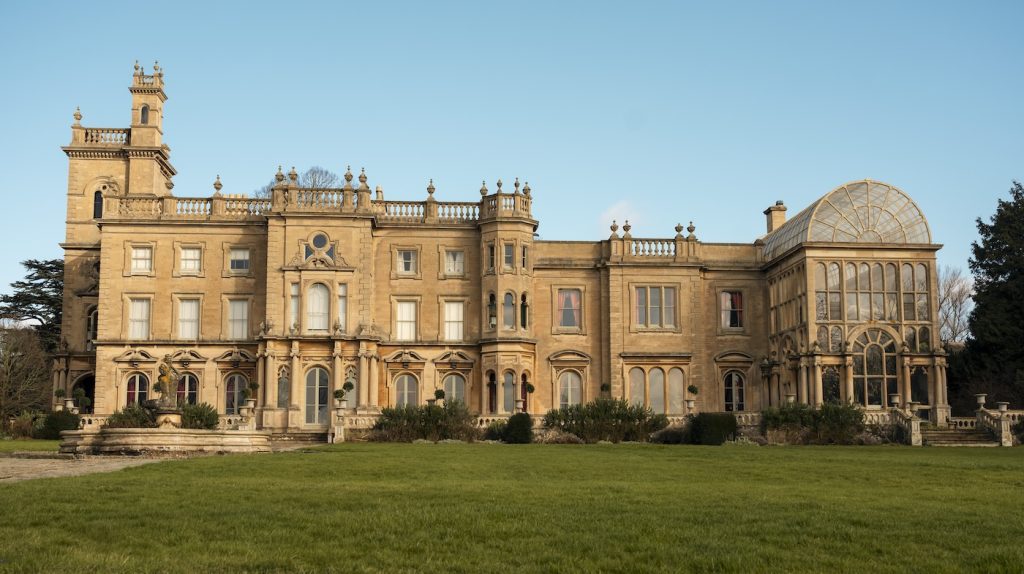
That’s a tall order. How did you go about locating your ultimate destination: Flintham Hall in rural Nottinghamshire?
I happened to be in the UK doing re-shoots for The Marvels and had some extra time, so I took it upon myself to start looking, because I knew this house really needed to be special. Nia is very open to ideas, but she’s also extremely specific in her scripts. For Hedda‘s home, we needed a grand staircase, a library, a lake that we could see from the house, a ballroom or great room with a balcony on the second level that you can look down from, the ability to drop a chandelier [laughing], a period kitchen, a period bathroom, and ideally all in one house and 45 minutes from London.
That wish list is super specific. Tell me about your quest to find the perfect Hedda house.
Everything around London had been shot a million times so I worked my way out from there. A lot of these country houses are owned by the National Trust, and you cannot change anything. So I wanted privately owned homes but even then, I’d get to a house and the shutters could only be open four hours a day or “You can’t touch the draperies because we’re worried they’ll disintegrate” or you can’t move the harpsichord because it’s been in the family for hundreds of years.
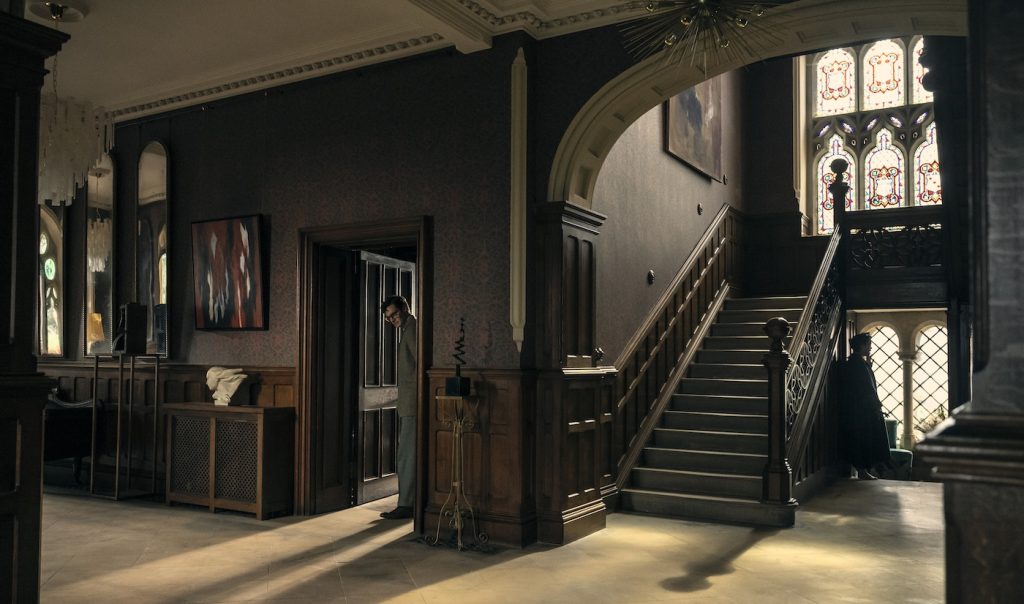
That’s a lot of restrictions.
I ended up I photo-scouting 200 homes and drove out to see many in person. Sometimes you’d find a house that looked interesting in the photographs but then you get there and it’s some Jacobean house from medieval times where everything’s tiny because the photos were taken with wide angle lenses.
That’s cheating! So after months of searching, you located a 10th-century estate in rural Nottinghamshire called Flintham Hall.
I brought on this amazing location manager Emma Pill and as soon as we got there and saw the balcony in the great room, I just knew. The owners thought it would be fun to make a movie there, so we came in and took over the house and transformed it.
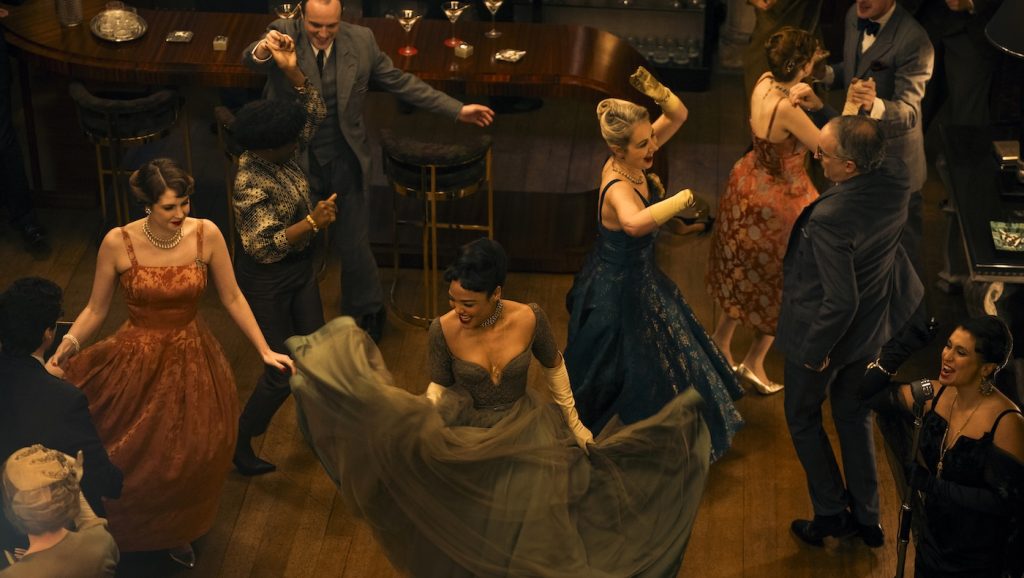
The interior reflects Hedda’s personality in such vivid ways. What were your inspirations?
What unlocked the design for me is that I read about socialites in the fifties who wanted to hang out in a modern world with artists and musicians and bohemians. I studied the book Vogue Hoses Gardens and People, which is about eccentric socialites with incredible houses in Europe filled with modern art. And I studied this book, “Luggala Days,” about the heiress Oonagh Guinness, who had an estate in Ireland that her father bought for her. I could not believe how she decorated it! She had green carpet, purple wallpaper, and a hot pink satin canopy around her bed. Oonagh hosted week-long parties with the Rolling Stones and different artists, so that’s when I understood: Hedda’s a creative modern woman who doesn’t have a way to express her creativity.
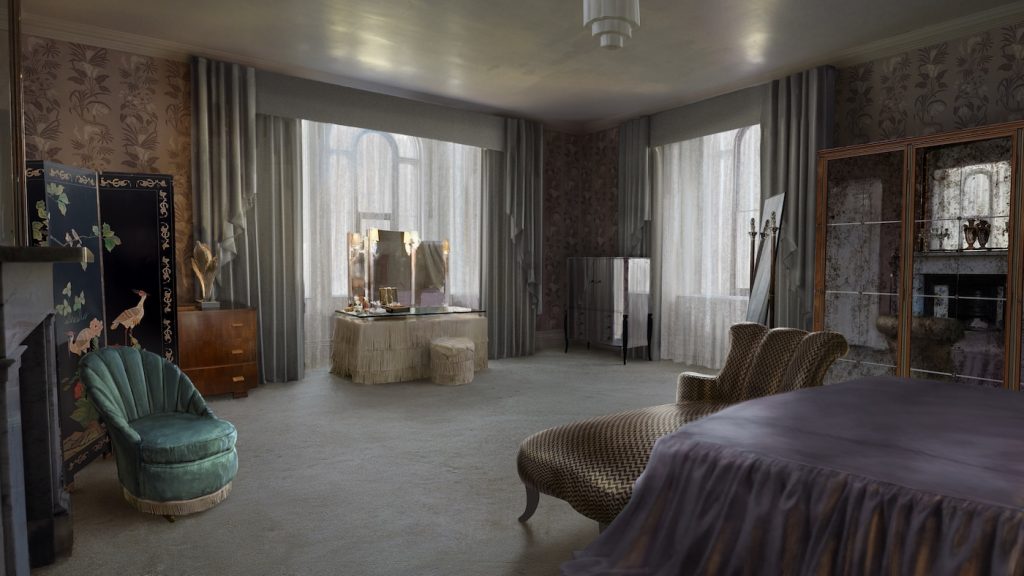
Since the owners of this country house gave you free rein to re-paint the walls, what color scheme did you go with?
I loved the idea of doing kind of putrid colors — I don’t know any other way to describe it — because I felt this house needed to be somewhat faded. I had a beautiful reference of Lauren Bacall in her bedroom with faded purple wallpaper, sort of a dusty purple, so I thought “Lets bring in some Hollywood glamor.” It should be sexy and beautiful, but also cold.
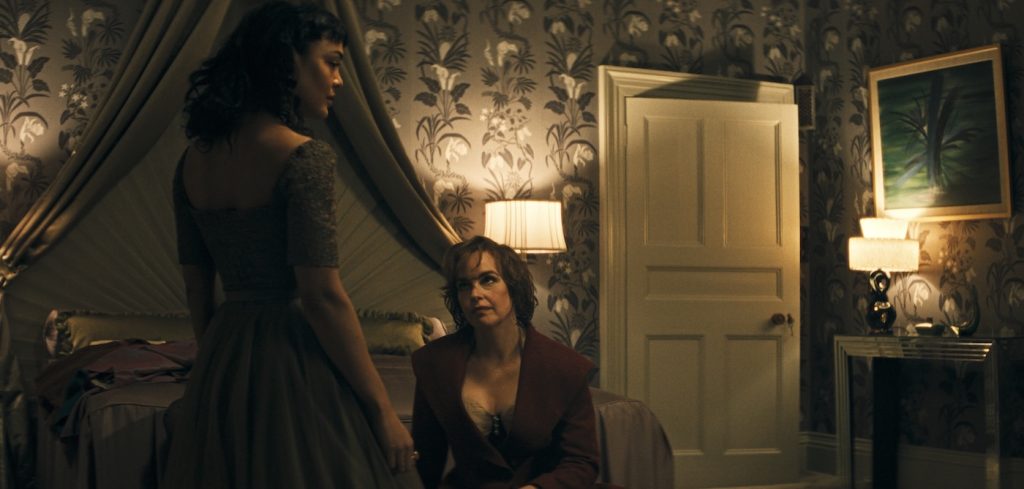
Early in the movie, servants are setting this extremely long dining room table covered with an equally long tablecloth. Hedda sweeps in and rips it off. What’s that about?
In my research, I learned that aristocratic dinner tables were usually covered in a white tablecloth, but in more artistic homes, where one might see Salvador Dalí and similar works, the tables were often beautiful and glossy. For her time, Hedda was really pushing the boundaries.
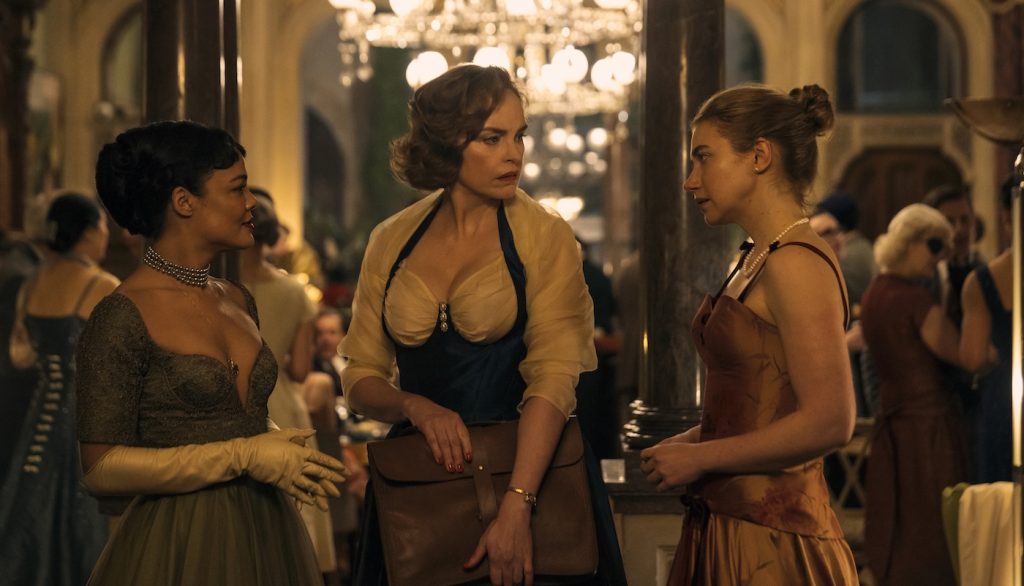
Also dramatic is the spangly chandelier that comes crashing down and shatters.
That was made from a sugar glass type of material. The weirdest thing is the set decorator had gotten an email from a person who makes custom chandeliers for films. Kismet.
Modern paintings reinforce the artistic vibe in Hedda’s house. Where did they come from?
We rented some, but for the most part, we made our own paintings. My set decorator Stella Fox and I sent images to this incredible painter Thomasina Smith, and she created dozens of versions [in the style of abstract expressionists Helen Frankenthaler, Arthur Dove, Clyfford Still, and surrealist Salvador Dali]. All the art in the great room and dining room is paintings that we had made.
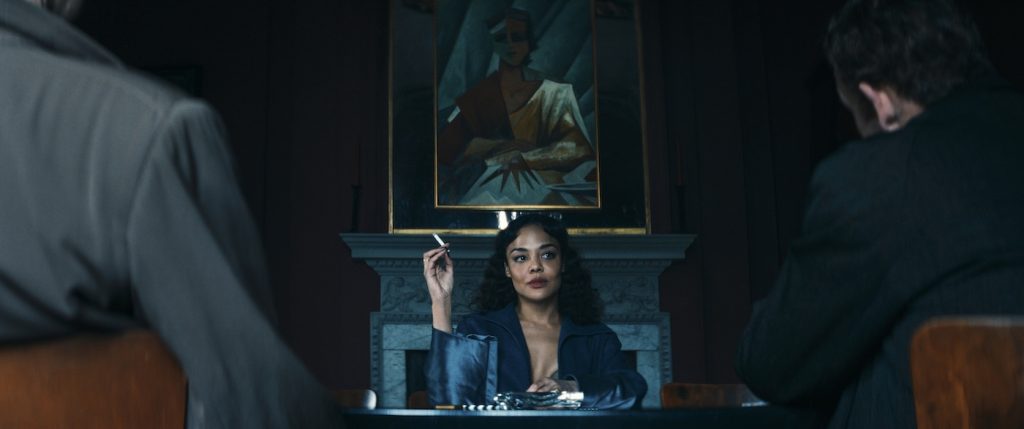
The architecture itself seems well-suited to the several bits of treachery revealed during the party. How did you exploit the old-fashioned floor plan?
There are all these little nooks and secret hideaways in the house, so it was really fun to go around with Nia and realize, for example, that we could utilize this little nook right there for when Hedda goes off with the Judge [Nicholas Pinnock] for their secret kiss.
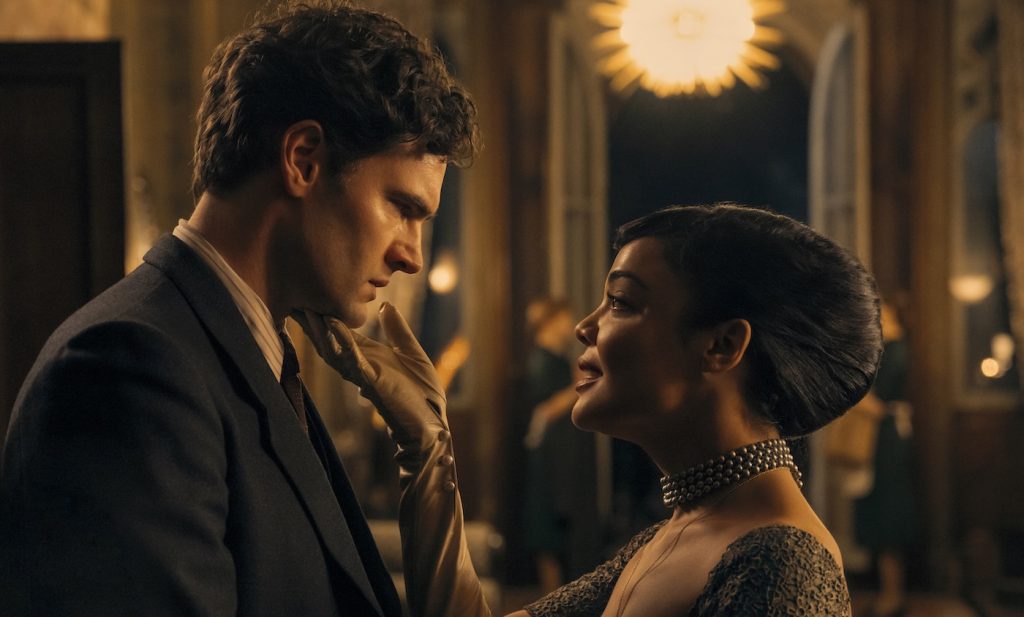
The bucolic lake in the back of the estate looks very cinematic and expands the narrative space when drunk partygoers go skinny-dipping there. The lake also plays an important role in Nia DaCosta’s version of the Hedda story. Did you need to modify the lake to make it work for the plot?
We put a platform at the bottom of the lake so Tessa could walk in and go down to exactly her height. The area around the lake was completely overgrown with brambles, so we created that little shoreline area to make it all feel seamless.
Hedda is the third movie you’ve designed for Nia DaCosta, dating back to Candyman in 2021, then The Marvels, and now this. What’s she like to work with?
Nia is calm, she’s organized, she knows exactly what she wants, so she makes decisions like that [snapping fingers]. She’s very prepared, she storyboards everything, she shoots very efficiently, and Nia doesn’t get upset with anybody on the crew. She’s a dream to work with. And I realized on Hedda how much we learned on The Marvels. Because that was a beast.
How so?
We thought we knew what we were getting into, but I don’t think anybody really knows when they sign up for a Marvel film what they’re getting into.
It must be a very different thing to work within the Marvel Cinematic Universe, which is sprawling and interconnected.
You’re playing in their sandbox. You can be creative within it, but there are parameters. The fun thing about Hedda was that there were no set builds, no green screen, just one location, and it was very contained. Plan B [Entertainment] was involved through [co-president] Jeremy Kleiner, but he was a delight. For the most part, we were left to make the film that Nia wanted to make, and that was exhilarating.
This interview is part of our celebration of production designers during International Production Designers Week, which runs from October 17 – 26.



